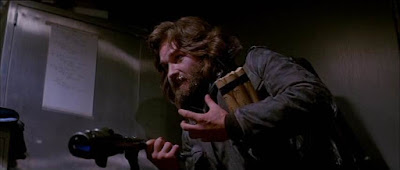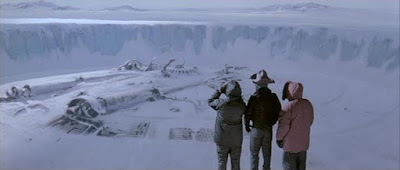(1982) Directed by John Carpenter; Written by Bill Lancaster; Based on a story by John W. Campbell, Jr.; Starring: Kurt Russell, Wilford Brimley, Keith David, Richard Dysart and Donald Moffat;
Available on DVD and Blu Ray
Rating: *****
What’s It About?
The opening scene of The Thing presents a mystery, as the two surviving members of a doomed Norwegian outpost mercilessly pursue a sled dog across the Antarctic wasteland, and stumble onto a neighboring American research station. This puzzling and ultimately unfortunate encounter leads the Americans back to the Norwegian outpost, which now lies in ruins, with all of its personnel dead. The Americans quickly learn that the Norwegian researchers had discovered a crashed alien spacecraft, along with one its occupants, entombed in the ice for 100,000 years. One of the only remaining clues in the Norwegian encampment is a hideous twisted mass of human flesh, which the Americans bring back to base for further study.
As the American team begins to put the pieces together about what happened to the Norwegian team, they become aware that the extra-terrestrial creature might not have been dead, but dormant. The true horror of the creature does not reside in its true appearance (we never actually see its original form), but in what it can imitate. Its cells act independently to copy other living things, spreading like an infection. If the replication is allowed to continue, the planet will be overrun by the copies, and life as we know it will cease to exist. Paranoia and tension build as everyone becomes a suspect, and the thing strives to divide and conquer the beleaguered researchers. In an effort to stop the alien life form, the men try to devise a plan to deduce who’s still human, and who’s not.
Much of the suspense and tension can be credited to the fine ensemble work by the cast. Kurt Russell is great as the jaded helicopter pilot MacReady. You get the sense that Antarctica is the perfect home for his character, since he appears to have turned his back on the rest of the world. Many of the supporting cast members turn in equally impressive performances, but Wilford Brimley especially stands out as Blair. If you’ve only seen him pushing Quaker Oats, or as the spokesman for diabetics everywhere, then you’re in for an unexpected treat. Blair is the first of the American team to realize the potential impact of the alien creature on human life, and the first of the American team to become unhinged. His cold assessment of the situation gives way to madness, resulting in his makeshift incarceration by the rest of the frightened researchers.
Without a doubt, the film’s true star is Rob Bottin, whose nightmarish effects work brings the shape-shifting organism in The Thing to life. His repulsive creations do an admirable job of displaying the creature in all of its various stages of transformation. The myriad forms are deliciously horrendous and astonishingly unique.
Why It’s Still Relevant:
The word “remake” typically carries a negative stigma, implying that nothing could possibly be as good as the original. Remakes are generally regarded as inferior knockoffs that emphasize style over substance and have little else to say. Historically speaking, this is true. Good, or even great, remakes are a rarity (the 1954 version of 20,000 Leagues Under The Sea, or the 1978 version of Invasion of the Body Snatchers, are a couple of notable exceptions), which often leads them to being summarily dismissed by critics and filmgoers alike. It’s probably this bias alone that prevented John Carpenter’s version from gaining more critical acclaim during its initial release.
John Carpenter’s version closely follows John W. Campbell’s original 1938 novella, “Who Goes There?” not with a slavish dedication to the original source material, but attention to what matters. He skillfully retains the elements of paranoia and thoughtful discussions about how the creature replicates other life forms, as well as speculation about the thing’s origins. MacReady makes the simple but profound statement, “I know I’m human.” Being an original and not a copy means something. What makes us still “us?” This seems fairly abstract unless we consider that our own cells are continually dying off and being replaced by new cells. Technically speaking, we’re not the same person we were before. Carpenter does not explicitly engage in an ontological discussion of the nature of our existence. His intent is to shock, to scare, and to keep us guessing. Once the alien organism is loose, we can never be sure who’s real, and who’s a copy. Is MacReady truly human, or is he really the thing, trying to deceive the remaining humans?
There’s no denying the fact that Howard Hawks’ The Thing from Another World was a landmark film for its time, as well as a tremendous influence for John Carpenter. Clips from the original film are featured prominently in John Carpenter’s Halloween, foreshadowing the remake to come. Carpenter’s The Thing is the rare remake that surpasses the original Howard Hawks version. This might sound blasphemous in some circles, but Carpenter’s version remains more faithful to Campbell’s paranoid vision. By comparison, Hawks’ version seems the more conventional monster flick, with its “monster on the loose” theme.
Early criticism of The Thing introduced the word “nihilistic” to my vocabulary. Although this word could be used to superficially describe John Carpenter’s film, it’s also indicative of his uncompromising vision. The Thing is unrelentingly grim – no one’s going to get the warm fuzzies from this film, but the tone is necessary to convey the utter hopelessness of the situation. True horror dwells in the realization that a situation might be unwinnable. The characters in the film face two equally unsavory prospects: complete assimilation or total annihilation. Another uncompromising element is the all-male cast – not the most marketable decision, but once again, true to the source material.
Rob Bottin created some of the most innovative practical effects work in movie history, with a craftsmanship that could not be matched by CGI. The effects were literally handmade instead of being rendered on a computer screen. There is an aesthetic, tactile difference that holds up remarkably well nearly 30 years later.
The Thing stands out as one of John Carpenter’s best films, as well as one of the best examples of the successful marriage of horror and science fiction. Ironically, another remake is in the works. I’m doubtful that it could be as effective, but I guess that’s just my own bias against remakes. John Carpenter’s film is the definitive version of Campbell’s story, and remains as effective today as the first time I saw it during its original, underappreciated theatrical run.













No comments:
Post a Comment